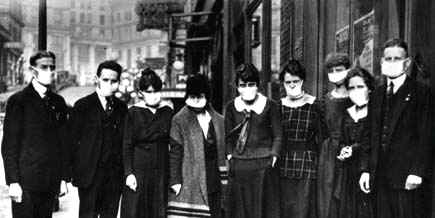|
THE INFLUENZA PANDEMIC
OF 1918

The influenza of 1918-1919, before the end and right after World War I (which
killed 9 million men in 4 years), caused the death of at least 25 million
people in one year. This was no minor disease - everyone on the planet
was at risk, and it most likely started in the U. S. of A. In one year,
nearly twenty million cases were reported in the United States, accounting for
almost one million deaths. The cause is still unknown, but is believed to
have been a mutated swine virus.
 |
It all started on the morning of March 11, 1918 at Camp Funston, Kansas. A
company cook named Albert Mitchell reported to the infirmary with typical
flu-like symptoms - a low-grade fever, mild sore throat, slight headache, and
muscle aches. Bed rest was recommended. By noon, 107 soldiers were sick. Within
two days, 522 people were sick. Many were gravely ill with severe pneumonia. Then
reports started coming in from other military bases around the country. Thousands
of sailors docked off the East Coast were sick. Within a week, the
influenza was hitting isolated places, such as the island of Alcatraz. Whatever
the cause, it was clearly airborne. Within seven days, every state in the
Union had been infected. Then it spread across the Atlantic.
 |
By April, French troops and civilians were infected. By mid-April, the
disease had spread to China and Japan. By May, the virus was spread
throughout Africa and South America. The actual killer was the pneumonia
that accompanied the infection. In Philadelphia, 158 out of every 1000
people died. 148 out of 1000 in Baltimore. 109 out of 1000 in Washington, D. C.. Children
would skip rope to the rhyme:
- I had a little bird,
- Its name was Enza.
- I opened the window,
- And in-flu-enza.
Doctors
were baffled when they first came across the virus. They didnít know what it
was, however, they suggested
some anti-flu precautions:
1.
Wash inside nose with soap and water each night and morning
2.
Force yourself to sneeze night and morning, then breathe deeply
3.
Do not wear a muffler (a wooly scarf that was popular in those days)
4.
Take quick
walks regularly and walk home from work
5.
Eat plenty of porridge
The good news (if there was any) was that the disease peaked within two to
three weeks after showing up in a given city. It left as quickly as it arrived.
The United States death toll was a total of 850,000 people, making it an area
of the world that was least devastated by this virus. Sixty percent of the
Eskimo population was wiped out in Nome, Alaska. 80-90% of the Samoan
population was infected, many of the survivors dying from starvation (they
lacked the energy to feed themselves). Luxury ocean liners from Europe
would arrive in New York with 7% less passengers than they embarked with. The
confined area of the ship was especially conducive to the spread of the disease. In
the end, 25 million people had died. Some estimates put the number as high as 37
million.
 |
| The influenza vaccine has proven
to be effective in significantly reducing the more serious consequences of
the influenza virus. |
Eighteen months after the disease appeared, the flu bug vanished and has
never shown up again. So what happened? Until recently, no one was
really sure. In March of 1997, the news broke that researchers at the
Armed Forces Institute of Pathology in Washington, D. C. had isolated genetic
material from the virus. This was no easy task. The living virus is
no longer around. It turns out that while conducting autopsies in 1918,
Army doctors had preserved some specimens in formaldehyde. One of these
jars contained the lungs of a 21 year old soldier that died on September 26,
1918. Bingo! The researchers spent nearly two years extracting just
seven percent of the genetic code, but the evidence gathered has provided a
great wealth of information. It appears that the virus passed from birds to
pigs and then to humans. These are the deadliest of all viruses. The
viruses tend to remain stable in the birds, but occasionally they infect pigs.
Of course, the pig immune system kicks into action and the virus is forced to
mutate to survive. Both the Asian flu (1957) and the Hong Kong flu (1968),
which were not as deadly, mutated from pig viruses. |